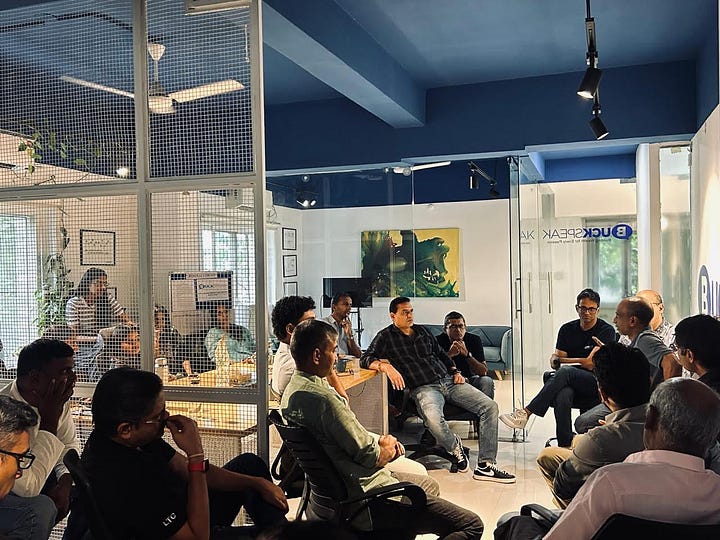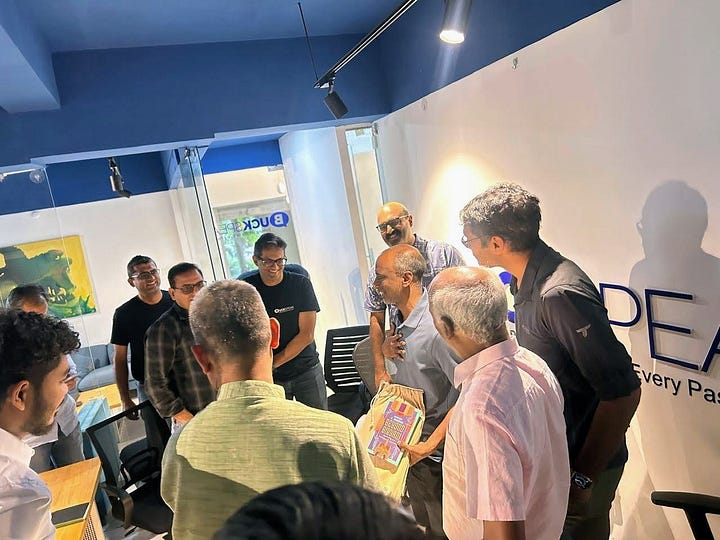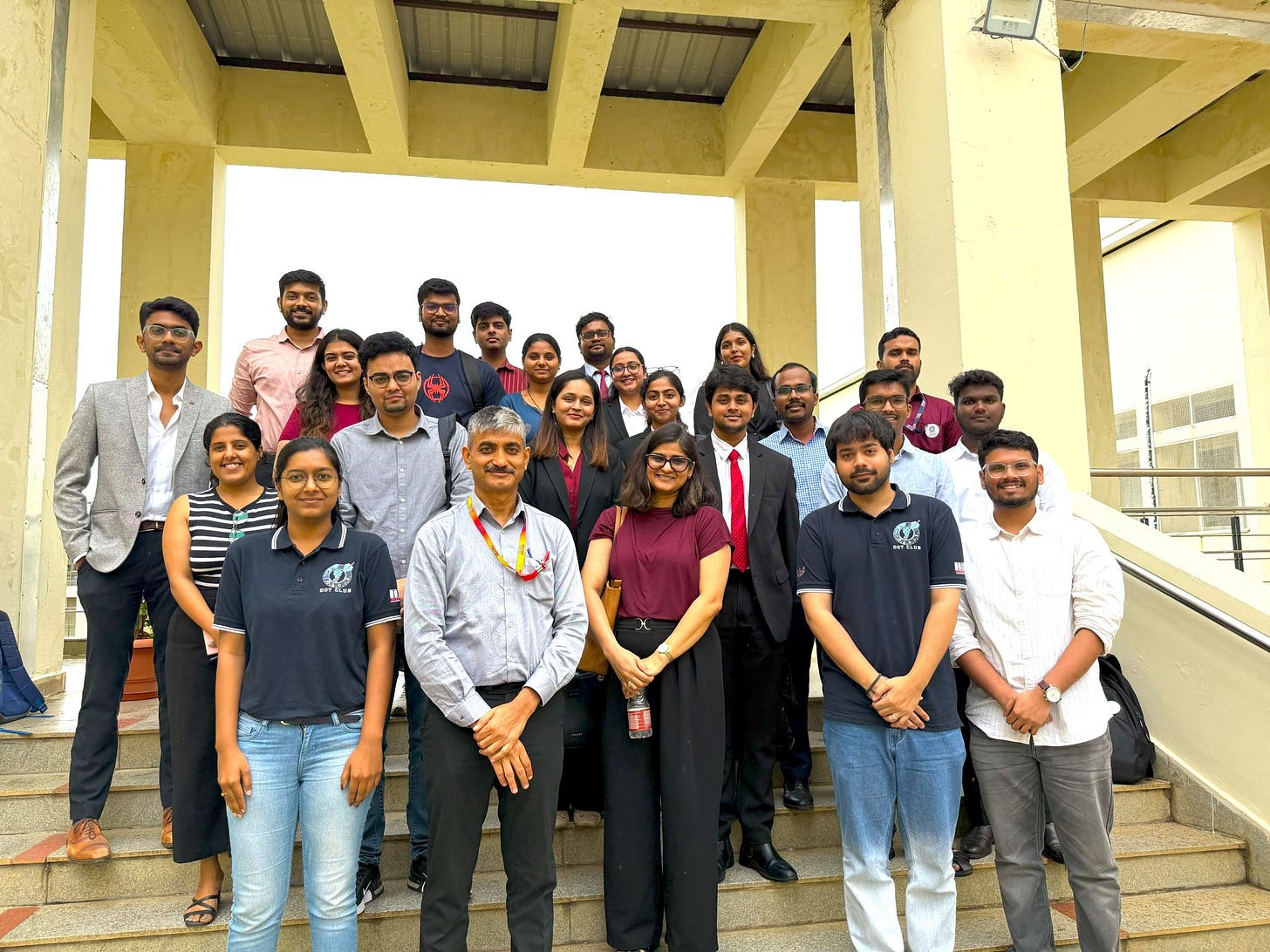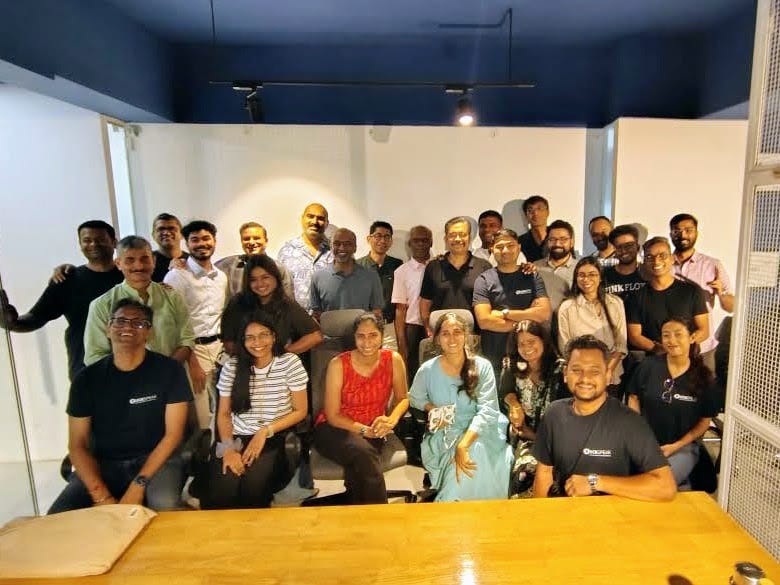As the semester draws to a close, I find myself reflecting on the subtle balance between tools and talent, between systems and sensibilities. Uzma Rizvi’s narrative of her consulting career offered a fitting reminder. She spoke not of frameworks alone, but of the habits of mind and heart that endure in an era of accelerating technology. The craft of consulting, she argued, has never been merely about generating insights—it is about structuring ambiguity, guiding decision makers, and holding the confidence of those navigating change.
Technology, in its many forms, has always shifted the way consultants work, from spreadsheets to slide decks, and now from algorithms to autonomous agents. Yet what remains consistent is the distinctly human ability to listen deeply, read between the lines, and translate numbers into narratives that move organisations forward. Uzma’s emphasis on empathy, trust, and influence underscored this truth: the best consultants do not just analyse—they align, inspire, and enable.
As I think of my own students stepping into their professional journeys, I see their challenge less as a battle against machines and more as a test of their ability to pair human insight with technological fluency. The future will reward those who know when to rely on agents and when to rely on judgement. It will belong to those who can orchestrate both with grace.
In the end, it is not about human versus machine. It is about remembering that behind every system, there is a story—and it is the human voice that makes it worth telling.
DTW
During the Week, Nvidia, the world’s most valuable publicly traded company, announced a $100 billion investment in OpenAI, reinforcing the centrality of AI infrastructure in the enterprise landscape. This is what the leadership said about the rationale-
“NVIDIA and OpenAI have pushed each other for a decade, from the first DGX supercomputer to the breakthrough of ChatGPT,” said Jensen Huang, founder and CEO of NVIDIA. “This investment and infrastructure partnership mark the next leap forward — deploying 10 gigawatts to power the next era of intelligence.”
“Everything starts with compute,” said Sam Altman, cofounder and CEO of OpenAI. “Compute infrastructure will be the basis for the economy of the future, and we will utilize what we’re building with NVIDIA to both create new AI breakthroughs and empower people and businesses with them at scale.”
Meanwhile, McKinsey’s latest piece on The Agentic Organization frames what might be the most radical organisational redesign since the Industrial and Digital revolutions. The central claim: firms are moving toward hybrid “agentic” operating models where humans work side-by-side with AI agents—virtual (knowledge workers in code) and physical (robots, drones, self-driving machines). What distinguishes this model is not incremental automation, but the systemic restructuring of workflows, decision rights, and value creation at near-zero marginal cost.
Simultaneously, global talent mobility is under pressure. The tightening of the H-1B visa regime in the United States has created a pivotal moment for India. The new visa fee structure, combined with broader US policy shifts, is prompting skilled Indian professionals to reconsider overseas deployments. Rather than a simple disruption, this represents an opportunity for India’s professional services ecosystem to absorb globally experienced talent, converting reverse brain drain into a strategic advantage. Firms like BCG are already positioning for this reality: on September 24, 2025, BCG inaugurated its Hyderabad office at Salarpuria Sattva Knowledge City, HITEC City, marking its third South Indian hub. This office is envisioned not merely as a workplace but as a collaborative, future-ready environment designed to attract, retain, and deploy talent across high-value services in manufacturing, R&D, technology, pharma, and real estate. Hyderabad, with its unique blend of industrial strength and technology density, is emerging as a strategic node for talent deployment—particularly in light of the H-1B squeeze.
These three seemingly unrelated developments not only underscores the potential of accelerating capabilities of agentic AI but might also highlights a tectonic shift in professional services, where firms are racing to integrate AI agents into core workflows. Agentic AI—autonomous systems capable of decision-making and action without constant human oversight—is beginning to disrupt strategy, technology, legal, and specialized advisory services, driving both operational transformation and new client expectations.
The convergence of these developments illustrates the reshaping of professional services through the lens of The Big Restack (TBR) Framework, which examines transformations across four dimensions: complement shifts, architecture, tempos, and constraints.
Complement Shifts reveal where value pools are migrating. Traditional project-based consulting, legal advisory, and engineering services are giving way to AI-augmented models where intellectual property, proprietary workflows, and platform-based delivery increasingly capture value. AI agents can autonomously generate strategy insights, analyze contracts, or simulate engineering scenarios, allowing firms to scale their offerings beyond conventional time-bound projects. These shifts also reflect the reallocation of talent: engineers returning from H-1B assignments bring domain expertise and global project experience that can now be leveraged in high-value, AI-augmented services within India’s GCCs or newly established hubs like BCG Hyderabad. Rather than merely replacing human effort, agentic AI complements human judgment, enabling firms to offer faster, more precise, and higher-impact advisory.
Architecture focuses on workflow reconfiguration. AI agents are transforming the structure of professional services engagements. In consulting, client teams are increasingly hybrid—combining humans, AI agents, and reusable data assets. For instance, strategy teams embed agentic AI into research, scenario planning, and financial modeling, allowing consultants to focus on interpretation, client communication, and strategic decision-making. Legal teams leverage AI agents for contract review, due diligence, and compliance monitoring, while engineering firms automate design simulations and predictive maintenance workflows. The architectural redesign extends beyond client-facing workflows: back-office functions, knowledge management, and internal collaboration are also restructured, creating AI-native operating models. Organizations that fail to redesign workflows risk underutilizing AI capabilities or generating outputs that frustrate clients and teams alike—a phenomenon McKinsey terms “AI slop.”
Tempos capture the speed and rhythm of adoption. Firms experimenting with AI agents rapidly iterate on pilot projects, learning loops, and human-AI collaboration protocols. Early adopters gain market share, accelerate capability-building, and set client expectations for speed and quality. Meanwhile, the H-1B disruption accelerates adoption tempos in India. With a potential reverse brain drain, firms can deploy highly skilled engineers, consultants, and legal experts in domestic hubs faster than ever before, transforming India from a cost arbitrage destination to a global innovation and execution center. Rapid experimentation with AI agents, supported by globally experienced talent, allows firms to refine delivery models and unlock new services, creating a cumulative advantage over slower-moving competitors.
Constraints highlight the bottlenecks that define competitive advantage. Proprietary data, regulatory compliance, domain expertise, and client relationships are increasingly critical. AI agents’ effectiveness depends on high-quality, domain-specific data; firms that cultivate rich data moats around their core practices can build agents that outperform generic models. Governance and reliability frameworks are essential to ensure agentic AI outputs are trusted and actionable, especially in legal, financial, and advisory contexts. Moreover, client relationships remain a defining constraint: while AI agents can augment research and analysis, nuanced judgment, negotiation, and strategic communication continue to require human expertise. In this way, constraints define the boundaries within which firms must orchestrate AI, human talent, and client engagement to maintain and expand competitive advantage.
The implications of agentic AI for professional services are far-reaching. Firms are already leaning into building the AI stack—from workflow redesign to data integration, platform strategies, and governance layers. Startups and GCCs are experimenting with hybrid human-AI models, often in niche high-value areas like digital transformation, AI-driven risk modeling, and platformized service delivery. In parallel, private markets are signaling where orchestration opportunities exist: AI-native ventures and investment flows indicate that scalable agentic AI solutions for professional services will be a key competitive differentiator in the coming decade.
Activate proprietary data for intelligent agents is another critical lever. Leading firms are building internal data lakes, curating domain-specific knowledge, and developing reusable prompts and training assets. By creating structured, high-quality datasets, they enable AI agents to learn more effectively, generate reliable insights, and replicate best practices across engagements. This approach also supports the creation of AI-augmented service products, allowing firms to move from bespoke project delivery toward scalable offerings—turning previously manual services into standardized yet flexible AI-powered solutions.
Platform strategies are replacing traditional project-based delivery. Firms are exploring subscription models, AI-assisted toolkits, and on-demand expert networks. Strategic startup investments are accelerating this transition: AI-first ventures in analytics, contract review, financial modeling, and engineering simulation provide a preview of the future consultant toolkit, where human judgment is amplified by intelligent systems. As service delivery shifts, pricing models are evolving, with outcome-based, subscription, and hybrid models emerging as AI enables higher predictability, efficiency, and client value.
Building the human-AI workforce is the final frontier. Professional services firms face significant workforce restructuring, balancing efficiency gains from AI with the need for judgment-driven human input. AI-native startups demonstrate the potential of lean, hybrid teams, while traditional firms must re-skill and redeploy existing talent to manage, supervise, and collaborate with AI agents. The scarcity of AI-savvy professionals, coupled with the H-1B constraints, makes domestic talent cultivation and strategic workforce planning a priority. Here, India’s GCCs and urban hubs like Hyderabad can absorb returning talent, accelerate AI adoption, and establish a competitive moat that blends human expertise with agentic intelligence.
In essence, the TBR framework illustrates how professional services are entering a massive restack: value pools are shifting, workflows are being redesigned, adoption tempos are accelerating, and constraints are defining the next frontier of competitive advantage. Nvidia’s investment in OpenAI exemplifies the technological potential that is now within reach, while H-1B policy shifts create a talent and strategic arbitrage that India’s professional services ecosystem is uniquely positioned to exploit. BCG Hyderabad embodies this new reality—a hub designed not only for delivery efficiency but also for collaboration, talent development, and AI-driven innovation.
As we see more agents AI solutions evolve, the lessons are clear: successful firms will orchestrate the AI stack effectively, activate proprietary data, turn services into scalable AI-augmented products, and continuously rebuild human-AI workflows. They will leverage complement shifts to identify growth areas, redesign architectures to optimise collaboration, manage tempos to accelerate learning, and navigate constraints to secure a durable competitive advantage. For individual experts, the opportunity lies in embracing agentic AI, deepening domain expertise, and cultivating cross-cultural, global, and digital skills—turning disruption into a platform for professional growth.
So, where do young graduates and mid-career managers go from here? In The Matrix, Neo finally stops running and faces the Agents head-on. Bullets freeze mid-air, and suddenly it’s the machines who look nervous.
I like to imagine this as the consultant’s moment of clarity—when the endless slides, data dumps, and AI outputs lose their power, and the human insight cuts through. Neo doesn’t just dodge anymore; he bends the rules. That’s the reminder: AI may flood the field, but it’s still the human who decides which rules to rewrite.
I particularly remember the moment in The Matrix when Neo finally believes? He rises calmly after being knocked down, dusts himself off, and with a casual wave of the hand, invites the Agent to “bring it on.”
On a different note, that’s the energy many of my students might need during the ongoing placement process when they get knocked down by circumstances beyond their control. . Not panic at every punch, but the confidence to get up, look the disruption in the eye, and say: your move.
In conclusion, professional services are no longer defined solely by traditional content expertise or project execution. The future is hybrid, AI-augmented, and platform-oriented. Firms and individuals who understand and act on the TBR dimensions—complements, architecture, tempos, and constraints—will lead the next wave of transformation, redefining how value is created, captured, and delivered in the AI era. India, with its deep talent pool, expanding GCCs, and strategic investments in AI infrastructure, is poised to become a global nerve center, turning policy disruptions into opportunity, and technology innovation into enduring professional advantage.
OTW
Over The Weekend, I had the joy of attending BuckSpeak’s Baithak with G Satish Raju, someone who has been my mentor in running since 2014 and has played a pivotal role in shaping the Peerancheruvu Runners (PCR) into one of Hyderabad’s most vibrant running communities. Beyond his professional accomplishments—as an IIT Kharagpur and IIM Ahmedabad alumnus, former Country Head at Swiss Re, and current head of sales at Planet—what has always inspired me is Satish’s philosophy of mentorship and impact.
During the Baithak, Satish spoke about choosing benchmarks thoughtfully—not as mere personal milestones, but as reference points that guide growth, inspire others, and shape communities. His reflections reminded me that success is never just about individual achievement; it is about the collective energy, guidance, and opportunities we create for those around us.
The afternoon seamlessly blended insight with connection. Stories of professional life, leadership, and mentorship flowed alongside shared experiences from audience. We discussed the subtle ways mentors can catalyse both personal and organisational growth, the importance of nurturing emerging talent, and how the impact of guidance often multiplies quietly over time.


As always, the Baithak concluded with good food, rich conversations, and the warmth of being part of a community that values learning, perseverance, and meaningful connections. Overall, I felt invigorated—not just by the ideas, but by the enduring reminder that benchmarks are powerful when they point toward collective progress, and mentorship is the legacy that truly endures.
Wishing you Happy Navratri.
I love you.
Shailendra




Happy Navaratri.